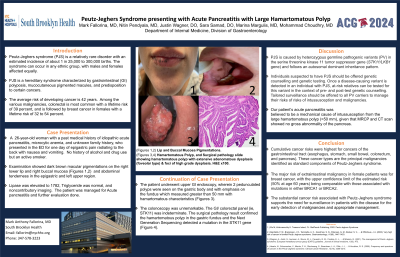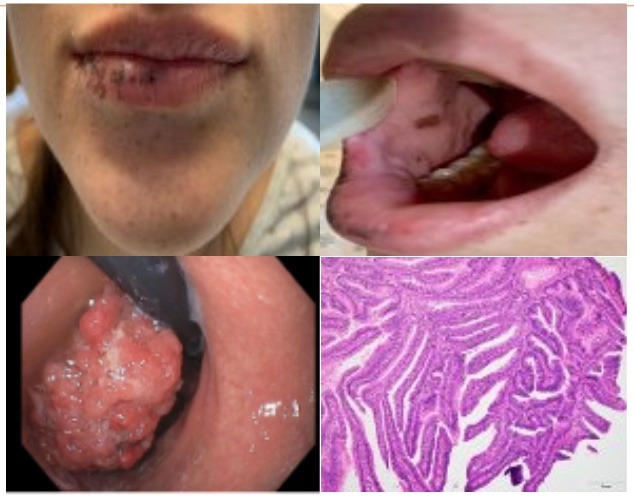Monday Poster Session
Category: Stomach
P3393 - Peutz-Jeghers Syndrome Presenting With Acute Pancreatitis With Large Hamartomatous Polyp
Monday, October 28, 2024
10:30 AM - 4:00 PM ET
Location: Exhibit Hall E

Has Audio

Mark Anthony Fallorina, MD
NYC Health + Hospitals/South Brooklyn Health
Brooklyn, NY
Presenting Author(s)
Mark Anthony Fallorina, MD1, Nitin Pendyala, MD1, Justin Wagner, DO1, Sara Samad, DO1, Marina Margulis, MD1, Mohammad Choudhry, MD2, Christopher Chum, DO2
1NYC Health + Hospitals/South Brooklyn Health, Brooklyn, NY; 2South Brooklyn Health, Brooklyn, NY
Introduction: Peutz-Jeghers syndrome (PJS) is a relatively rare disorder with an estimated incidence of about 1 in 25,000 to 300,000 births. The syndrome can occur in any ethnic group, with males and females affected equally. PJS is a hereditary syndrome characterized by gastrointestinal (GI) polyposis, mucocutaneous pigmented macules, and predisposition to certain cancers. The average risk of developing cancer is 42 years. Among the various malignancies, colorectal is most common with a lifetime risk of 39 percent, and is followed by breast cancer in females with a lifetime risk of 32 to 54 percent.
Case Description/Methods: We report a case of a 26-year-old woman with a past medical history of idiopathic acute pancreatitis, microcytic anemia, who presented in the ED with epigastric pain radiating to the back with nausea and vomiting. No history of alcohol and drug use but an active smoker. Examination showed dark brown macular pigmentations on the right lower lip and right buccal mucosa and abdominal tenderness in the epigastric and left upper region.
Lipase elevated to 1782, normal triglyceride, and noncontributory imaging. The patient was managed for acute pancreatitis and further evaluation done. MRCP showed concerning volvulus versus intussusception in the stomach and duodenal area. The patient underwent upper GI endoscopy, wherein 2 pedunculated polyps were seen on the gastric body and with emphasis on the fundus which measured greater than 50 mm with hamartomatous characteristics. The colonoscopy was unremarkable. The GI/ colorectal panel (ie, STK11) was indeterminate. Surgical pathology confirmed the hamartomatous polyp in the gastric fundus and Next Generation Sequencing detected a mutation in the STK11 gene.
Discussion: PJS is caused by heterozygous germline pathogenic variants (PV) in the serine threonine kinase 11 tumor suppressor gene (STK11/LKB1 gene) and follows an autosomal dominant inheritance pattern. Individuals suspected to have PJS should be offered genetic counselling and genetic testing. Tailored surveillance should be offered to all PV carriers to manage their risks of intussusception and malignancies. Our patient’s acute pancreatitis was believed to be a mechanical cause of intussusception from the large hamartomatous polyp ( >50 mm), given that MRCP and CT scan showed no gross abnormality of the pancreas.

Disclosures:
Mark Anthony Fallorina, MD1, Nitin Pendyala, MD1, Justin Wagner, DO1, Sara Samad, DO1, Marina Margulis, MD1, Mohammad Choudhry, MD2, Christopher Chum, DO2. P3393 - Peutz-Jeghers Syndrome Presenting With Acute Pancreatitis With Large Hamartomatous Polyp, ACG 2024 Annual Scientific Meeting Abstracts. Philadelphia, PA: American College of Gastroenterology.
1NYC Health + Hospitals/South Brooklyn Health, Brooklyn, NY; 2South Brooklyn Health, Brooklyn, NY
Introduction: Peutz-Jeghers syndrome (PJS) is a relatively rare disorder with an estimated incidence of about 1 in 25,000 to 300,000 births. The syndrome can occur in any ethnic group, with males and females affected equally. PJS is a hereditary syndrome characterized by gastrointestinal (GI) polyposis, mucocutaneous pigmented macules, and predisposition to certain cancers. The average risk of developing cancer is 42 years. Among the various malignancies, colorectal is most common with a lifetime risk of 39 percent, and is followed by breast cancer in females with a lifetime risk of 32 to 54 percent.
Case Description/Methods: We report a case of a 26-year-old woman with a past medical history of idiopathic acute pancreatitis, microcytic anemia, who presented in the ED with epigastric pain radiating to the back with nausea and vomiting. No history of alcohol and drug use but an active smoker. Examination showed dark brown macular pigmentations on the right lower lip and right buccal mucosa and abdominal tenderness in the epigastric and left upper region.
Lipase elevated to 1782, normal triglyceride, and noncontributory imaging. The patient was managed for acute pancreatitis and further evaluation done. MRCP showed concerning volvulus versus intussusception in the stomach and duodenal area. The patient underwent upper GI endoscopy, wherein 2 pedunculated polyps were seen on the gastric body and with emphasis on the fundus which measured greater than 50 mm with hamartomatous characteristics. The colonoscopy was unremarkable. The GI/ colorectal panel (ie, STK11) was indeterminate. Surgical pathology confirmed the hamartomatous polyp in the gastric fundus and Next Generation Sequencing detected a mutation in the STK11 gene.
Discussion: PJS is caused by heterozygous germline pathogenic variants (PV) in the serine threonine kinase 11 tumor suppressor gene (STK11/LKB1 gene) and follows an autosomal dominant inheritance pattern. Individuals suspected to have PJS should be offered genetic counselling and genetic testing. Tailored surveillance should be offered to all PV carriers to manage their risks of intussusception and malignancies. Our patient’s acute pancreatitis was believed to be a mechanical cause of intussusception from the large hamartomatous polyp ( >50 mm), given that MRCP and CT scan showed no gross abnormality of the pancreas.

Figure: (Figures 1,2,3,4) Lip and Buccal Pigmentations, Hamartomatous Polyp, and Surgical pathology slide showing hamartomatous polyp with extensive adenomatous dysplasia (foveolar type) & foci of high grade dysplasia. H&E x10
Disclosures:
Mark Anthony Fallorina indicated no relevant financial relationships.
Nitin Pendyala indicated no relevant financial relationships.
Justin Wagner indicated no relevant financial relationships.
Sara Samad indicated no relevant financial relationships.
Marina Margulis indicated no relevant financial relationships.
Mohammad Choudhry indicated no relevant financial relationships.
Christopher Chum indicated no relevant financial relationships.
Mark Anthony Fallorina, MD1, Nitin Pendyala, MD1, Justin Wagner, DO1, Sara Samad, DO1, Marina Margulis, MD1, Mohammad Choudhry, MD2, Christopher Chum, DO2. P3393 - Peutz-Jeghers Syndrome Presenting With Acute Pancreatitis With Large Hamartomatous Polyp, ACG 2024 Annual Scientific Meeting Abstracts. Philadelphia, PA: American College of Gastroenterology.
